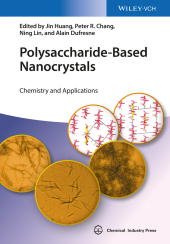 Neuerscheinungen 2015Stand: 2020-02-01 |
Schnellsuche
ISBN/Stichwort/Autor
|
Herderstraße 10
10625 Berlin
Tel.: 030 315 714 16
Fax 030 315 714 14
info@buchspektrum.de |

Peter R. Chang, Jin Huang, Ning Lin
(Beteiligte)
Polysaccharide-Based Nanocrystals
Chemistry and Applications
By Jin Huang, Peter R. Chang, Ning Lin et al.
1st ed. 2015. XVIII, 310 S. 120 SW-Abb. 244 mm
Verlag/Jahr: WILEY-VCH 2015
ISBN: 3-527-33619-2 (3527336192)
Neue ISBN: 978-3-527-33619-7 (9783527336197)
Preis und Lieferzeit: Bitte klicken
Polysaccharide nanocrystals can be derived from the renewable resources cellulose, chitin or starch, which makes them ideal candidates for "Green Materials Science". This versatile material class can be used in nanocomposites such as rubber or polyester, and in functional materials such as drug carriers, bio-inspired mechanically adaptive materials or membranes. Moreover, polysaccharide-based nanomaterials are environmentally friendly due to their intrinsic biodegradability.
With its interdisciplinary approach the book gives a thorough introduction to extraction, structure, properties, surface modification, theory, and mechanisms of material formation of polysaccharide nanocrystals from renewable resources. In addition, it provides an in-depth description of plastics, composites, and nanomaterials from cellulose nanocrystals, chitin nanowhiskers and starch nanocrystals.
The first focused, concise and coherent treatment of nanomaterials made from renewable resources such as cellulose, chitin, and starch - for scientists, engineers, graduate students and industrial researchers in the field of polymeric materials.
Preface
POLYSACCHARIDE NANOCRYSTALS: CURRENT STATUS AND PROSPECTS IN MATERIAL SCIENCE
Introduction to Polysaccharide Nanocrystals
Current Application of Polysaccharide Nanocrystals in Material Science
Prospects for Polysaccharide Nanocrystal-Based Materials
STRUCTURE AND PROPERTIES OF POLYSACCHARIDE NANOCRYSTALS
Introduction
Cellulose Nanocrystals
Chitin Nanocrystals
Starch Nanocrystals
Conclusion and Prospects
SURFACE MODIFICATION OF POLYSACCHARIDE NANOCRYSTALS
Introduction
Surface Chemistry of Polysaccharide Nanocrystals
Approaches and Strategies for Surface Modification
Adsorption of Surfactant
Hydrophobic Groups Resulting from Chemical Derivatization
Polymeric Chains from Physical Absorption or Chemical Grafting
Advanced Functional Groups and Modification
Concluding Remarks
PREPARATION OF POLYSACCHARIDE NANOCRYSTAL-BASED NANOCOMPOSITES
Introduction
Casting/Evaporation Processing
Thermoprocessing Methods
Preparation of Nanofibers by Electrospinning Technology
Sol-Gel Method
Self-Assembly Method
Other Methods and Prospects
POLYSACCHARIDE NANOCRYSTAL-REINFORCED NANOCOMPOSITES
Introduction
Rubber-Based Nanocomposites
Polyolefin-Based Nanocomposites
Polyurethane and Waterborne Polyurethane-Based Nanocomposites
Polyester-Based Nanocomposites
Starch-Based Nanocomposites
Protein-Based Nanocomposites
Concluding Remarks
POLYSACCHARIDE NANOCRYSTALS-BASED MATERIALS FOR ADVANCED APPLICATIONS
Introduction
Surface Characteristics Induced Functional Nanomaterials
Nano-Reinforcing Effects in Functional Nanomaterials
Optical Materials Derived from Liquid Crystalline Property
Special Films and Systems Ascribed to Barrier Property
Other Functional Applications
Concluding Remarks
CHARACTERIZATION OF POLYSACCHARIDE NANOCRYSTAL-BASED MATERIALS
Introduction
Mechanical Properties of Polysaccharide Nanocrystals
Dispersion of Polysaccharide Nanocrystals
Mechanical Properties of Polysaccharide Nanocrystal-Based Materials
Polysaccharide Nanocrystal/Matrix Interfacial InteractionsThermal Properties of Polysaccharide Nanocrystal-Based Materials
Barrier Properties of Polysacharide Nanocrystal-Based Materials
Concluding Remarks
Index


